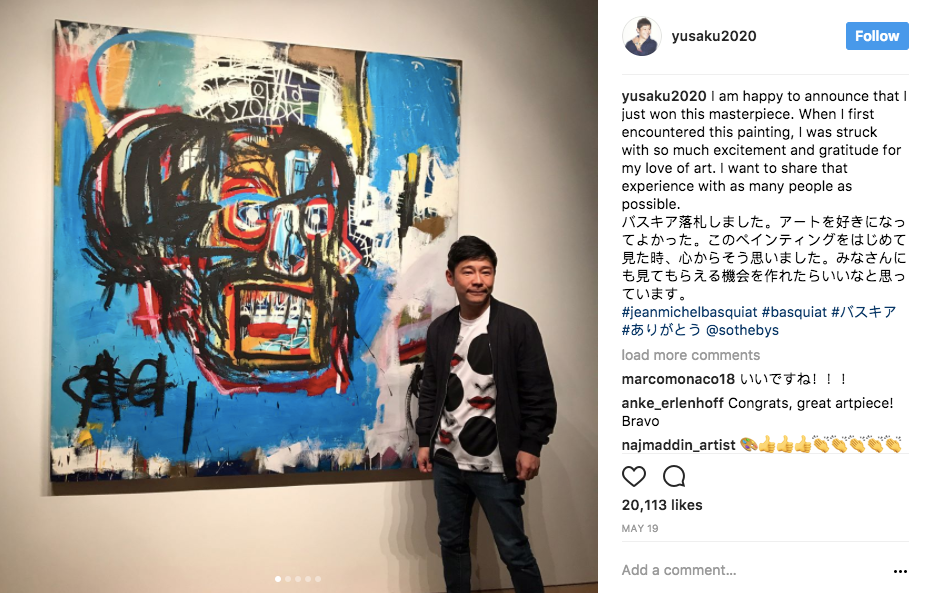TALL TALES
Only a few hours after Basel's VIP preview kicked off on Tuesday, every major art-media outlet in the game began dutifully churning out what their readership around the industry has come to expect in 2017: art-fair sales reports. And as always, the results didn't disappoint––regardless of whether you were looking for high commerce, high comedy, or (like me) both.

John Baldessari, Marian Goodman Gallery, Sprüth Magers ©Art Basel
Anyone with even minimal experience in the private market will tell you that knowledge is power there, especially at the upper echelons. It's one of the primary reasons that ambitious sellers go to such great lengths to maintain the asymmetry of information, i.e. to try to ensure they know more about the market than the people who want to buy from them at all times.
On any typical day in the industry, then, top-tier galleries and dealers would rather snort a line of fire ants than give out an asking price––let alone actual sales results––to anyone other than a "serious" collector, curator, or advisor. ARTnews even used to run a regular column called Price Check exclusively to relay the often Larry David-level awkwardness that ensued when its writers inquired about pricing and availability at the front desks of various high-end galleries.
And yet, remarkably, in the opening days of any fair, this core tenet of the business magically reverses! All of a sudden, even sector-leading sellers can't restrain themselves from divulging specific sales info to every warm body in possession of a notebook or smartphone. It's as if every exhibitor at the event has been possessed Exorcist style, only instead of Pazuzu, the inhabiting spirit is Ed Snowden.
Strangely, though, these sales almost invariably feature HUGE numbers that make the sellers sound TREMENDOUSLY successful and their inventory seem REALLY scarce.
Stranger still, the reports also happen to conveniently leave out any information that would allow even the most intrepid outsider to confirm whether any of these alleged deals actually went down as advertised. And this past week in the Messeplatz was no different, of course.
Hauser & Wirth was happy to announce to the world they'd sold a Piero Manzoni Achrome for €10 million... but not to whom. David Zwirner couldn't help but mention that they'd moved Sigmar Polke's Night Cap I for $8 million... but not to where. Lévy Gorvy was ecstatic to volunteer that they'd placed a large work by Dan Colen for $450,000 with "an American institution"... but this is about as useful as saying, "My favorite American president was, you know, that white guy."
So except in the rare cases where an actual buyer feels they have as much to gain by marketing their latest acquisition as the seller does, these alleged concessions to transparency leave fact-thirsty observers and analysts right back where we are for the rest of the year: groping around in the dark for something to satisfy us, like blind guests at a swingers' party.
I'm not saying everyone who appears in an art-fair sales report is lying through their teeth every time. But I am saying that the private market's universal closed-books policies means they COULD, and the mythmaking incentives that drive the industry suggest they SHOULD.
So whether you're trying to catch up on what happened at Art Basel 2017 or preparing to dig into the publicly available intel around the next major fair, remember that the wisest attitude (as usual) is this: Don't believe the hype.
[P.S. I'm not linking to a specific article because every platform is under equal pressure to provide this kind of coverage. Just as sex sells, sales reports wrangle readers.]
OVER/UNDER
A month after the record-detonating $110.5 million sale of Untitled (1982) to Japanese billionaire Yusaku Maezawa, it should come as no surprise that Art Basel's booths were ruled by the Radiant Child, Jean-Michel Basquiat. And his proliferation at the summer's marquee fair speaks to an often-overlooked aspect of market-making in the art industry.
As my artnet News colleague (and, full disclosure, editor) Julia Halperin pointed out, this year's fair offered no fewer than nine paintings by the late star, priced at a grand total of $89 million. (You can scope them all here.) And while Nate Freeman noted that Basquiat's untimely demise left "a scarce number of works produced during his peak years," it's also clear that, in our follow-the-leader industry, a long line of collectors are eager to sherpa their way toward the summit in pursuit of whatever remains.
Thanks to recent examples like Damien Hirst, who forced the concept of "quality over quantity" to walk the plank — long before the Wreck of the Unbelievable, even many casual observers understand that sought-after artists would be better off chugging saltwater than overproducing work.
However, what seldom gets discussed is that UNDER-PRODUCING can be just as deadly as the opposite for talent (and dealers) with grand ambitions. You can't make a market if you don't have enough building blocks to play with. A lack of inventory means too much demand goes unsatisfied for too long a time, and frustrated collectors inevitably pivot en masse to a trend that can actually sustain itself.
Sure, it's vital for the work to feel rare and exclusive ENOUGH to collectors. But as usual, there's a difference between the relative and the absolute. If you had a syringe full of truth serum, I suspect you could find a great example of this idea by asking Jeff Koons why his premier polychromed sculptures are often available in, say, "five unique versions"––good luck untangling the philosophical implications of that concept––instead of as genuine one-offs.
I'm not deeply in touch with the Basquiat market. But based on the number of seven-figure works available at Basel on, essentially, a month's notice, I suspect the reaper's scythe didn't do as much damage to the artist's long-term commercial prospects as it did to the artist himself. A short life can still be a prolific life. Which is why, apart from the articles I already cited, you can also catch Basquiat's name in the Basel-centric headlines of... [Bloomberg | The New York Times | Art Market Monitor | and others]

GET RICH OR SUBSIDIZE TRYING
Finally this week, let's take flight over another proposed art-market utopia, so we can drop a classic Gray Market reality bomb on it.
Late in Julia Halperin's savvy long read on the gruesome economics of art fairs for sub-elite galleries, she relayed an unorthodox solution from economic sociologist Olav Velthuis: namely, "for top galleries to subsidize smaller galleries’ participation" at events like Basel, which have become increasingly necessary for survival by the traditional rules of the game.
Velthuis himself expounded on this idea by saying, “I could imagine a situation where the community and the fair organizers recognize it’s important to have a mixed ecology... It’s just healthy for a market to have that.”
Of course, it would also be "healthy" for humanity to turn all of our bars and liquor stores into chamomile-tea rooms, but that doesn't mean it's going to happen.
Deep down, I'm sure Velthuis knows his proposal is a fantasy. He's done too much good work on the art industry in the past decade or so to ignore the increasingly winner-take-all nature it's assumed during that time.
But in contrast to his vision of Art Basel welfare, the truth is that the winners in a capitalist system generally don't subsidize their smaller, struggling competitors. They devour and absorb those competitors, especially when doing so can fill a perceived void in their overall sales profile.

David Zwirner's booth at Art Basel 2017 ©Art Basel
Consolidation is on the rise in nearly all 21st-century markets, including those for cultural goods. Consider mega-publisher HarperCollins's 2014 acquisition of romance-novel imprint Harlequin, the industry leader in a niche where the parent company previously had little market share... or Hollywood studio Lionsgate's 2016 acquisition of premium-cable network Starz, to control its subscriber base, digital-media apparatus, and film/TV library... or the fact that about two-thirds of all music sold now arrives courtesy of just three record labels, which have spent decades gobbling up smaller entities in their space to reach their current girth.
Admittedly, none of the above is a one-to-one analogy for the art industry in general or the art-fair sector specifically. But given that mega-galleries clearly recognize the long-term value in being able to offer works at lower price points––if they didn't, neither Pace Prints nor the Gagosian Shop would exist––I don't think they're likely to respond by developing a sudden urge for charitable giving.
Would top-down gallery/dealer acquisitions create a "mixed ecology" for art buyers? In the sense of meeting demand at a variety of price points rather than isolating all art-buying at the top, I suppose so. But they would also further consolidate the power and profitability of the most successful entities, at the expense of almost everyone else on the sell side––basically, paying lip service to diversity while sliding a dagger between its ribs.
That doesn't mean smaller galleries are necessarily doomed. However, it does mean that it may be time for them to consider more dramatic ways of reshaping their businesses than trying to play by the same rules as the big brands. Because if they start waiting for subsidies from the elites to save them, they're basically depending on the infamous "thoughts and prayers" strategy. And if you're not familiar with how that works, I've got some very, very bad news for you about the past decade or so of American life. [artnet News]
That’s all for this edition. Til next time, remember: All's fair in love and war.









